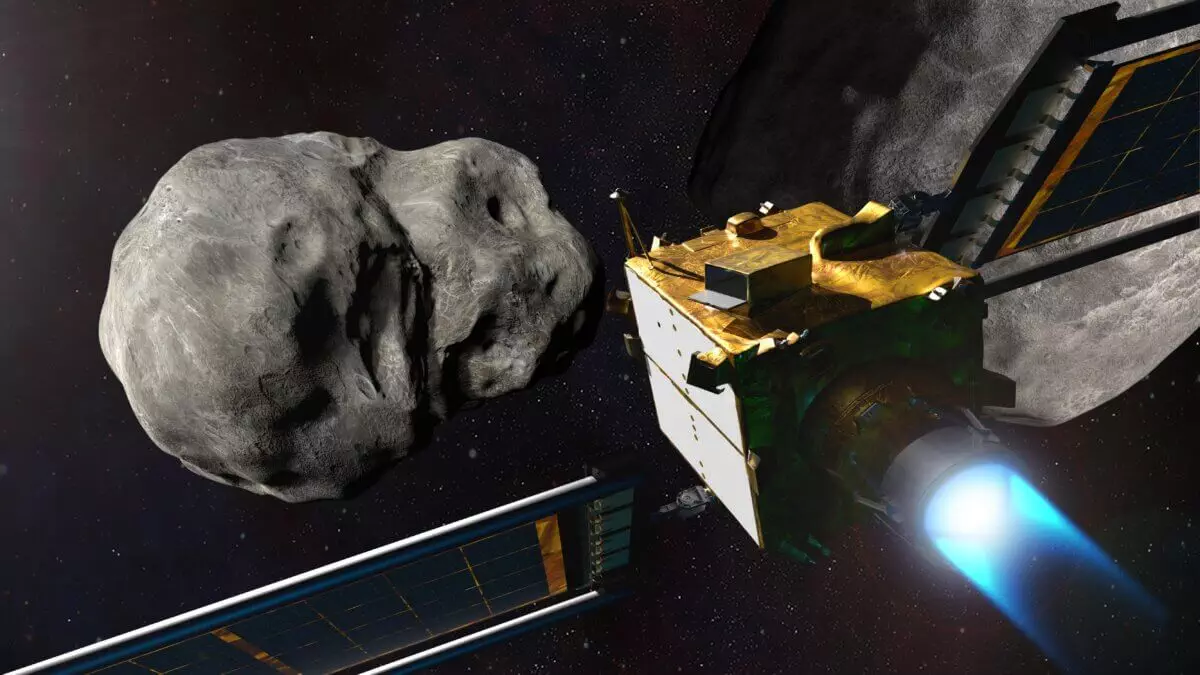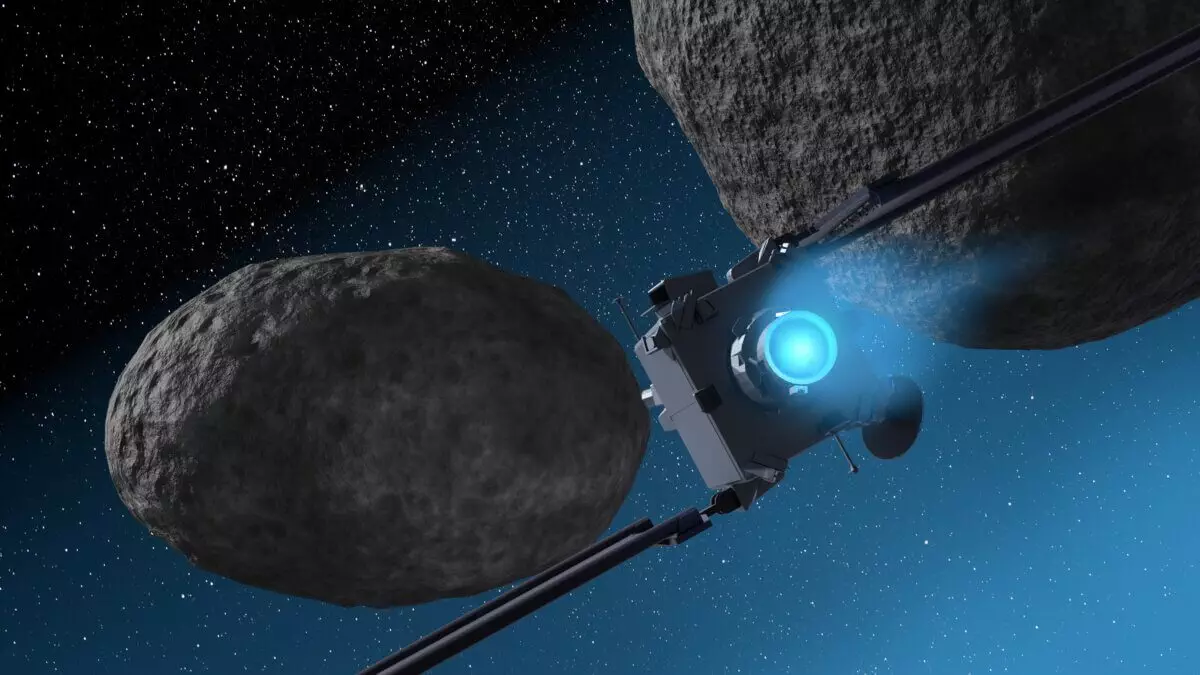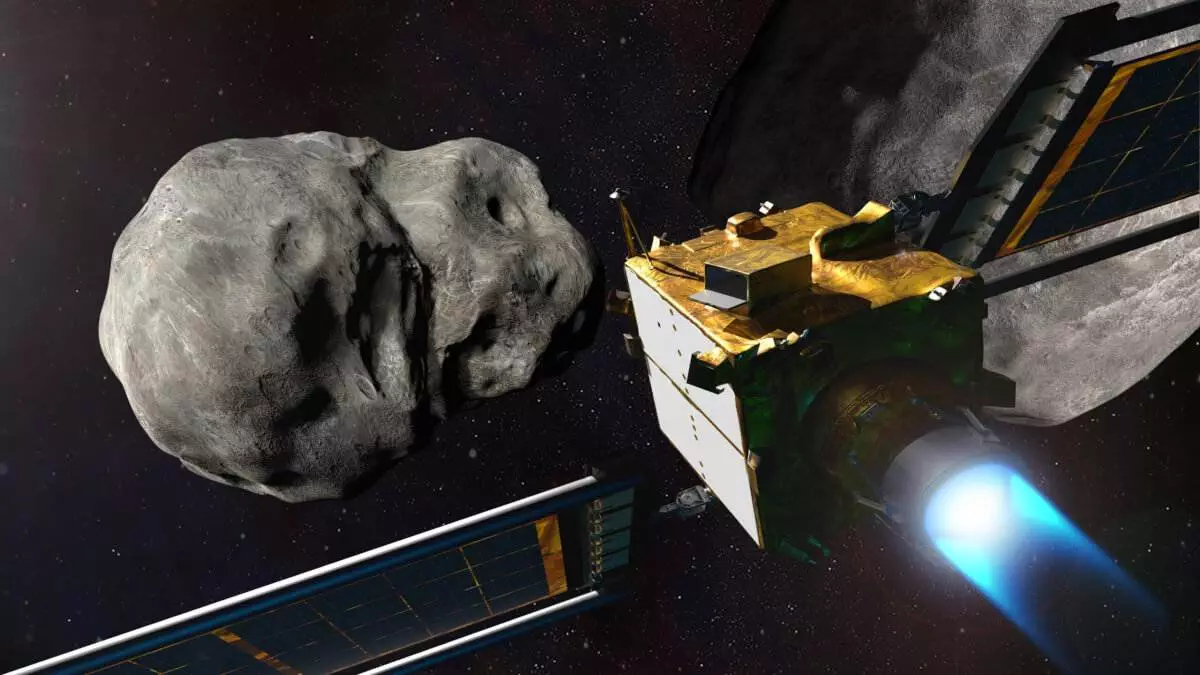NASA Space Technology

An illustration depicting NASAs Double Asteroid Redirection Test (DART) spacecraft prior to impact at the Didymos binary asteroid system. (Image courtesy of NASA/Johns Hopkins APL/Steve Gribben)
COLLEGE PARK, Md. — Remember when NASA deliberately crashed a spacecraft into an asteroid last year? Well, the aftermath of that cosmic collision just got a whole lot more interesting.
In a groundbreaking study published in the Planetary Science Journalscientists have uncovered some unexpected results from NASA’s Double Asteroid Redirection Test (DART) mission. It turns out that when DART slammed into the asteroid moon Dimorphos in 2022, it didn’t just leave a dent – it completely reshaped the celestial body and potentially set it on a chaotic new path.
Breaking down what happened and why it matters
First, a quick refresher: DART was NASA’s test run for planetary defense. The idea was to see if we could change the course of an asteroid by hitting it with a spacecraft – kind of like a game of cosmic billiards. The target was Dimorphos, a small asteroid moon orbiting a larger asteroid called Didymos.
Now, here’s where things get interesting. According to Derek Richardson, a professor of astronomy at the University of Maryland and a lead researcher on the DART mission, the impact did more than just nudge Dimorphos off course. It dramatically altered its shape.
Richardson explains that one of the biggest surprises was how much the shape of Dimorphos changed as a result of the DART mission. Originally, the asteroid moon was shaped like a hamburger, but the collision stretched it into the shape of a football.
This shape change is a big deal because it challenges what scientists thought they knew about how asteroid moons form. Previously, they believed these moons would naturally become elongated over time, always pointing their long axis toward the main asteroid they orbit. However, Dimorphos flipped the script, going from squished to stretched after the impact.
“This result contradicts that idea and indicates that something more complex is at work here. Furthermore, the impact-induced change in Dimorphos’ shape likely changed how it interacts with Didymos,” Prof. Richardson says in a university release.

DART knocked the asteroid off its course
The surprises didn’t stop with the asteroid moon changing shape. The DART impact may have set Dimorphos tumbling through space in an unpredictable way. Before the collision, Dimorphos was likely in a stable state, always showing the same face to Didymos (much like our Moon always shows the same face to Earth). Now? Not so much.
“Now, it’s knocked out of alignment, which means it may wobble back and forth in its orientation,” Richardson explains. “Dimorphos might also be ‘tumbling,’ meaning that we may have caused it to rotate chaotically and unpredictably.”
This unexpected tumbling raises new questions about the asteroid’s stability and internal structure. It could take a century or more for Dimorphos to settle back into a stable state, which has implications for future asteroid research and potential planetary defense strategies.
Speaking of future research, the European Space Agency is planning a follow-up mission called Hera, set to launch in October 2024. Hera will arrive at the Didymos-Dimorphos system in late 2026 to study both asteroids up close and provide more details about DART’s impact. One key question Hera might help answer is whether Dimorphos is stable enough for future spacecraft to land on.
“One of our biggest questions now is if Dimorphos is stable enough for spacecraft to land and install more research equipment on it,” Richardson notes.
While all of this might sound like abstract space science, it has very real implications for our planet’s safety. The DART mission and its aftermath are helping scientists refine strategies for defending Earth against potential asteroid or comet impacts.
“DART gave us insight into complicated gravitational physics that you can’t do in a lab, and all of this research helps us calibrate our efforts to defend Earth in the event of an actual threat. There’s a nonzero chance that an asteroid or comet will approach and endanger the planet. Now, we have an additional line of defense against these kinds of external threats,” Richardson concludes.
Paper Summary
Methodology
NASAs approach was surprisingly straightforward: send a spacecraft speeding toward an asteroid at over 14,000 miles per hour and let physics do the rest. DART was designed to be a kinetic impactora fancy term for a high-speed projectile. The spacecraft itself was relatively simple, with its main objective being to crash into Dimorphos.
Before the impact, scientists made detailed observations of the Didymos system to predict the pre- and post-impact dynamics. Using high-powered telescopes, they monitored the orbital behavior of Dimorphos around Didymos, giving them a clear baseline against which to measure any changes after the impact.
When DART hit Dimorphos, the collision created a cloud of debris, or ejecta, that further pushed Dimorphos, amplifying the impact’s effectiveness. The mission planners used this ejecta to their advantage, knowing that the force of the debris leaving the surface would contribute to altering the asteroid’s path.
Key Results
The DART mission was a resounding success. The impact altered the orbit of Dimorphos, reducing its orbital period from 11.92 hours to 11.37 hours. This was a significant change, far exceeding the mission’s minimum success criteria of altering the orbit by at least 73 seconds.
However, the impact did more than just change the orbit. It also likely altered the shape and spin of Dimorphos, possibly putting it into a tumbling state. This suggests that the asteroid may not be as stable as it once was, which has intriguing implications for future missions and our understanding of how such bodies behave after a collision.
Study Limitations
While the DART mission achieved its primary objectives, several uncertainties remain. One of the biggest unknowns is the exact mass of Dimorphos, which directly affects the calculations of how much momentum was transferred during the impact. The European Space Agency’s Hera mission, scheduled to arrive at the Didymos system in 2026, will provide critical follow-up data to resolve these uncertainties.
Another limitation is the long-term stability of the Didymos system. While the immediate effects of the impact are well-documented, it’s unclear how the system will evolve over time. Will the orbit of Dimorphos remain stable, or could it become more erratic due to the changes in its shape and spin?
Discussion & Takeaways
The success of the DART mission opens the door to a new era in planetary defense. For the first time, we have demonstrated that it is possible to alter the trajectory of an asteroid. This could be a game-changer in our ability to protect Earth from potential asteroid impacts.
However, this mission is just the beginning. The insights gained from DART will inform future missions, such as ESAs Hera, which will further study the Didymos system. These missions will help refine our techniques for asteroid deflection, ensuring that we are better prepared for any future threats.
Moreover, the DART mission highlights the importance of international collaboration in space. The combined efforts of NASA, ESA, and other partners are crucial in tackling the global challenge of planetary defense.
Funding & Disclosures
The DART mission was funded by NASAs Planetary Defense Coordination Office as part of its ongoing efforts to protect Earth from near-Earth objects. The mission was executed by the Johns Hopkins University Applied Physics Laboratory (APL), which built and operated the DART spacecraft. The European Space Agency (ESA) is responsible for the Hera mission, which will conduct follow-up observations of the Didymos system.
There are no conflicts of interest to disclose, and all findings from the DART mission have been shared with the global scientific community to advance our collective understanding of planetary defense.
About StudyFinds Staff
StudyFinds sets out to find new research that speaks to mass audiences without all the scientific jargon. The stories we publish are digestible, summarized versions of research that are intended to inform the reader as well as stir civil, educated debate. StudyFinds Staff articles are AI assisted, but always thoroughly reviewed and edited by a Study Finds staff member. Read our AI Policy for more information.
Our Editorial Team
Steve Fink
Editor-in-Chief
Sophia Naughton
Associate Editor


